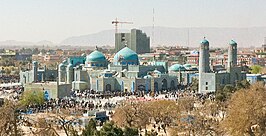
Back مزار شريف Arabic مزار شريف ARZ Mazar-e Sharif AST Məzari-Şərif Azerbaijani مزار شریف AZB Мазари-Шәриф Bashkir Мазары-Шарыф Byelorussian Мазары-Шарыф BE-X-OLD Мазари Шариф Bulgarian মাজার-ই-শরিফ Bengali/Bangla
Mazar-i-Sharīf | |
|---|---|
| مزار شریف | |
| Coordinates: 36°42′N 67°07′E / 36.700°N 67.117°E | |
| Country | |
| Province | Balkh |
| District | Nahri Shahi |
| Government | |
| • Mayor | Abdullhaq Khurami |
| Area | |
| • Land | 83 km2 (32 sq mi) |
| Elevation | 357 m (1,171 ft) |
| Population | |
• Estimate (2021) | 500,207[1] |
| Time zone | UTC+4:30 (Afghanistan Standard Time) |
| Climate | BSk |
Mazar-i-Sharīf (/məˈzæri ʃəˈriːf/ mə-ZARR-ee shə-REEF; Dari and Pashto: مزار شریف), also known as Mazar-e Sharīf or simply Mazar, is the fifth-largest city in Afghanistan by population, with an estimated 500,207 residents in 2021.[1] It is the capital of Balkh province and is linked by highways with Kunduz in the east, Kabul in the southeast, Herat in the southwest and Termez, Uzbekistan in the north. It is about 55 km (34 mi) from the Uzbek border. The city is also a tourist attraction because of its famous shrines as well as the Islamic and Hellenistic archeological sites. The ancient city of Balkh is also nearby.
The region around Mazar-i-Sharif has been historically part of Greater Khorasan and was controlled by the Tahirids followed by the Saffarids, Samanids, Ghaznavids, Ghurids, Ilkhanids, Timurids, and Khanate of Bukhara until 1751 when it became part of the Durrani Empire (although under autonomous emirs). Eventually the city passed to a few local rulers before becoming part of Afghanistan in 1849.
Mazar-i-Sharif is the regional hub of northern Afghanistan, located in close proximity to both Uzbekistan and Tajikistan. It is also home to an international airport. It has the highest percentage of built-up land (91%)[2] of all the Afghan provincial capitals, and it has additional built-up area extending beyond the municipal boundary but forming a part of the larger urban area. It is also the lowest-lying major city in the country, about 357 metres (1,171 ft) above sea level. The city was spared the devastation that occurred in the country's other large cities during the Soviet–Afghan War and subsequent civil war, and was long regarded as one of the safest cities in the country.[3]
On 14 August 2021, Mazar-i-Sharif was seized by Taliban fighters, becoming the twenty-fifth provincial capital to be captured by the Taliban as part of the wider 2021 Taliban offensive.
- ^ a b "Estimated Population of Afghanistan 2021–22" (PDF). National Statistic and Information Authority (NSIA). April 2021. Archived (PDF) from the original on June 24, 2021. Retrieved June 21, 2021.
- ^ "The State of Afghan Cities Report 2015". Archived from the original on 31 October 2015. Retrieved 21 October 2015.
- ^ Boone, Jon (2 April 2011). "Afghanistan: when gentle Mazar-e-Sharif erupted in violence". the Guardian. Retrieved 22 September 2018.








